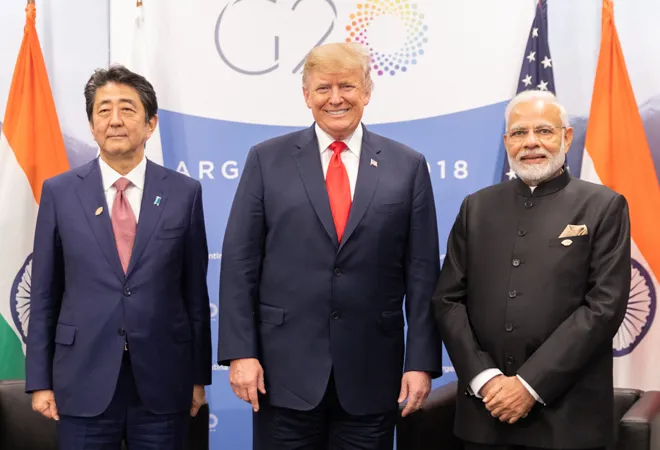-
CENTRES
Progammes & Centres
Location
Counter-proliferation, counterterrorism, maritime security, maritime domain awareness and HADR are some of the potential areas for JAI to work together.

Discovering the commercial and political significance of the Indo-Pacific, the G20 2018 summit in Buenos Aires saw the first trilateral meeting between Japanese Prime Minister Shinzo Abe, American President Donald J. Trump and Indian Prime Minister Narendra Modi. The trilateral JAI dialogue focuses on achieving a ‘free, open and inclusive Indo-Pacific’ for all. Leaders of the three countries reiterated their shared fundamental values, ensuring peace and security in the region. While China’s claims on the South China Sea remains a challenge, the aim of the trilateral dialogue is not only to overcome the Chinese threat, but also to maintain connectivity with Southeast Asia — and to establish a rules-based order in the Indo-Pacific.
The central issue of Freedom of Navigation begins with the Chinese encroachment of South China Sea (SCS), challenging international agreement on Oceans (defining the rights and responsibilities of nations with respect to their use of world's ocean), which is a core principle of UNCLOS hence disturbing the international order. To reduce tensions in the region, ASEAN and China have come together to formulate an SCS Code of Conduct. The individual stance of the JAI trilateral partners leans towards supporting an early conclusion of the SCS Code of Conduct and securing a legally binding code for the parties.
The individual stance of the JAI trilateral partners leans towards supporting an early conclusion of the SCS Code of Conduct and securing a legally binding code for the parties.
The geopolitics of the region is undergoing an unprecedented transformation. The unilateral Chinese actions in the SCS, such as building of the Great Wall of Sands has created issues for Southeast Asian countries. Realising its inability to stand up to China, Southeast Asian countries have been compelled to look to external powers and bilateral partners such as the US, India and Japan to back their rights in the region. JAI is ambitious; it wants to conduct its business in the waters of SCS, and encourage these archipelago countries to trade freely. This trilateral dialogue has enforced the idea of ‘Indo-Pacific’ as compared to the popular ‘Asia-Pacific’ — with the coming together of three prominent democracies in the world. JAI’s ambition to have a “free and open sea for all” can be achieved through multilateral connectivity, engaging in sustainable development programmes, promoting maritime security, providing disaster relief and ensuring freedom of navigation in international waters.
JAI has conducted two trilateral summits till now and has hardly any path-breaking achievement to show. Even after recognising the threats and challenges in the Indo-Pacific region, the trilateral dialogue has not taken any concrete steps to mitigate the tensions in the contested regions of Indo-Pacific. Still in the early stages, JAI has only been able to have a trilateral naval exercise (Malabar Exercise), which was initially instituted as a bilateral naval exercise.
The three partners have differing views on the strategy for the region. While India’s strategy is not identical but complementary to US and Japan’s strategy for the region, it has emphasised on ‘inclusiveness’ in its Indo-Pacific position. Not being on the same page is a major impediment for JAI. Also differing views on the ‘Indo-Pacific’ for the members of the dialogue itself is a cause of concern to ensure that the Indo-Pacific concept does not create misunderstandings. Having immediate bilateral economic and trade ties with China, no one is willing to go directly against Chinese belligerence. Thus, considering these circumstances JAI as a newly developed dialogue still has a long way to go.
While India’s strategy is not identical but complementary to US and Japan’s strategy for the region, it has emphasised on ‘inclusiveness’ in its Indo-Pacific position.
JAI dialogue in the Indo-Pacific aims to contribute towards mutual economic investments and interests, strong strategic partnership, and maritime cooperation. Having conducted two productive trilateral summits in the margins of the G20 Osaka Summit, leaders of JAI have pushed the agenda for securing energy, freedom of navigation without violating the law of sea and even to extend this cooperation in new domains including space, cyberspace and investments in quality infrastructure.
With bilateral cooperation already existing between Tokyo and New Delhi in the naval and maritime security domains and agreements to collaborate on infrastructure projects in third countries and India-US cooperating in Asian and African countries in several sectors, there is ample scope to scale up the bilateral into a trilateral cooperation between the three partners. Counter-proliferation, counterterrorism, maritime security, maritime domain awareness and Humanitarian Assistance and Disaster Relief (HADR) are some of the potential areas for JAI to work together and scale-up the trilateral dialogue to a more formalised structure.
There is a indeed a need to formalise the JAI trilateral dialogue through regular summit level meetings and expansion of the multidimensional partnership to areas beyond strategic issues.
The author is a research intern at ORF New Delhi.
The views expressed above belong to the author(s). ORF research and analyses now available on Telegram! Click here to access our curated content — blogs, longforms and interviews.